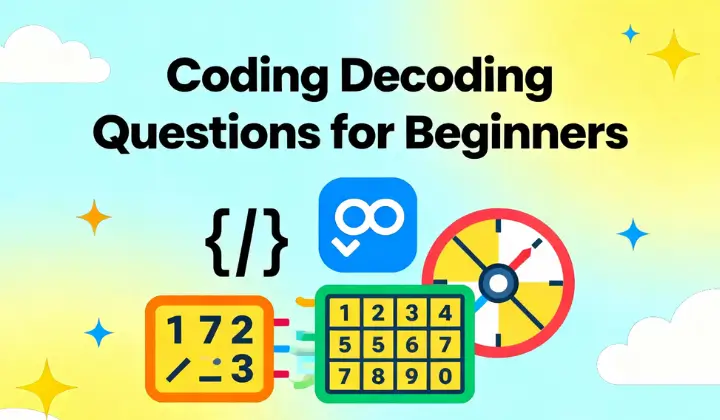Coding–Decoding is one of the most common and scoring topics in the Reasoning Ability section of competitive exams like IBPS, SBI, SSC, Railways, Insurance, and other government recruitment tests. It checks your ability to understand patterns, logical connections, substitution rules, and analytical thinking. For beginners, mastering the basics can significantly boost accuracy and speed. Here’s a simple and beginner-friendly guide to help you understand Coding and decoding from scratch.
Coding Decoding Questions for Beginners
Coding–Decoding is a fundamental reasoning topic that helps beginners understand how words, letters, or numbers are transformed using specific logic or patterns. It involves identifying rules such as alphabetical shifts, reversals, substitutions, or number positions to decode or encode a given message. With simple patterns and high scoring potential, mastering the basics of coding–decoding improves logical thinking and boosts performance in competitive exams.
Types of Coding Decoding (For Beginners)
Coding Decoding questions test how quickly you can identify hidden patterns in letters, numbers, and symbols. Whether it’s shifting alphabets, assigning numerical values, or cracking substitution rules, these questions check your ability to decode information under pressure.
1. Letter Coding
In this type, each letter of a word is replaced with another letter based on a fixed pattern such as shifting forward/backward in the alphabet.
Example:
CAT → DBU
(Each letter is shifted by +1)
2. Number Coding
Words or letters are coded using numbers based on alphabetical positions or a specific numeric logic.
Example:
DOG → 15
(D + O + G = 4 + 15 + 7)
3. Substitution Coding
Here, words are replaced with completely different words. The logic is based on substituting one term with another predefined term.
Example:
If “apple” is coded as “tree” and “tree” is coded as “fruit”, then what is “apple”?
Answer: tree
4. Mixed Coding
Sentences are coded using a combination of symbols, letters, or numbers. This type is commonly seen in SSC and similar exams.
5. Conditional Coding
These questions follow logical conditions similar to “If–Else” statements, where the output depends on fulfilling specific conditions.
Tips to Score High in Coding–Decoding
Scoring well in Coding–Decoding is all about spotting patterns quickly and applying them accurately. With the right approach and practice, this topic can become one of the easiest scoring areas in the reasoning section.
1. Understand Common Patterns: Most questions follow predictable patterns such as alphabetical shifts, numerical substitutions, or word replacements. Mastering these basics helps you crack questions faster.
2. Memorize Alphabet Positions: Knowing A = 1 to Z = 26 improves speed and reduces calculation time, especially for number coding and letter shifting.
3. Look for Consistency in the Rule: The same logic is applied to all parts of the question. Once you identify the pattern in one example, apply it uniformly to find the answer.
4. Practice Mixed Coding Regularly: Mixed coding questions may include symbols, numbers, or random codes. Practicing these frequently helps you decode patterns with confidence during exams.
5. Avoid Overthinking: Patterns are usually simple. Don’t assume complex logic unless necessary. Stick to basic shifts and substitutions first.
6. Work on Speed and Accuracy: Timed practice improves your ability to spot patterns quickly. Try solving 10–15 coding questions regularly to maintain fluency.
7. Decode Before Options: Try to identify the pattern on your own before checking answer choices. Options can sometimes mislead you if you rely on guesswork.
| Related Posts | |
| Basic Concepts of Syllogism with Examples | Inequality Tricks for Beginners |




 Government Appoints New Executive Direct...
Government Appoints New Executive Direct...
 Bank of America India Gets New CEO, RBI ...
Bank of America India Gets New CEO, RBI ...
 Most important topic for IBPS RRB Clerk ...
Most important topic for IBPS RRB Clerk ...







